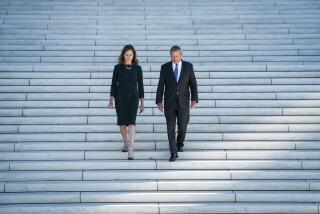Bush vs. Gore a Recent-History Lesson for Law Schools
- Share via
WASHINGTON — The Supreme Court settled the presidential election, but its ruling in the Florida recount case is being argued over and over at America’s law schools.
“It’s obvious that law students are as deeply divided over the case as the justices were and the public is,” said Erwin Chemerinsky, a USC law professor. “Bush vs. Gore will be talked about in law school classes for the rest of my career and beyond.”
Added Yale law professor Akhil Reed Amar: “This is a case that really can’t be ignored. This is as important a case--perhaps because you can’t fit it into the existing framework--as there has been in my academic career.”
The justices’ bitterly divided 5-4 decision on Dec. 12 shut down the Florida recount sought by Democrat Al Gore and in effect gave the presidency to Republican George W. Bush. The justices said that varying recount standards allowed by the Florida Supreme Court violated equal-protection guarantees and that there was not enough time to start again.
Douglas Kmiec, a Pepperdine University law professor, said his students “want to cut through the rhetorical pieces and they want to get to the legal doctrine and . . . think themselves where it fits.”
Kmiec’s students will hold their own oral argument and vote, without first listening to the tape of the Supreme Court’s historic argument session. “The students will have to go some distance to match the real thing,” he said.
University of Utah law professor Michael McConnell was surprised when his students decided not to include the election case among the dozen current cases they are studying this semester.
“They unanimously voted not to,” McConnell said. “They said that they were sick of it.”
McConnell said he viewed the decision as a logical extension of the court’s long-standing “one person, one vote” doctrine.
Kmiec agreed, saying: “Gore said, ‘Count all the votes.’ Bush said, ‘Fine, count them all equally.’ ”
Chemerinsky said, “I’m going to focus on whether the Supreme Court even should have decided the case” or instead should have allowed the political process to resolve it.
“As a teacher I’m always looking for examples that will engage my students and that they can relate to from their own knowledge,” he said. “So far I’ve gotten, as could be predicted, very animated discussion.”
Chemerinsky believes the case was “absolutely wrongly decided,” but he said he tries to be neutral in presenting the issues in class.
Amar said he will teach the case “as one more of a long series of reminders that law students shouldn’t just have blind faith in the judiciary.”
“The rule of law is taking preexisting principles, applying it here and promising you will apply it again in the future,” he said.
The justices’ ruling said their consideration of the equal-protection issue “is limited to the present circumstances.” Therefore, one question for lawyers and scholars is whether the decision set any precedent for other cases.
The justices’ ruling, issued at night only three days after the court agreed to hear the case, featured a familiar 5-4 lineup: Chief Justice William H. Rehnquist and Justices Sandra Day O’Connor, Anthony M. Kennedy, Antonin Scalia and Clarence Thomas in the majority and Justices John Paul Stevens, David H. Souter, Ruth Bader Ginsburg and Stephen G. Breyer in dissent.
The decision included six written opinions: the unsigned majority opinion; a separate concurring opinion, by Rehnquist and joined by Scalia and Thomas, that sought to stop the recount on other grounds; and four separate dissents that sought to allow the recount.
Some observers believe Rehnquist’s opinion--which said the Florida Supreme Court misinterpreted state election law--may originally have been intended to be the majority opinion, and that O’Connor and Kennedy opted instead for the equal-protection logic.
More to Read
Get the L.A. Times Politics newsletter
Deeply reported insights into legislation, politics and policy from Sacramento, Washington and beyond. In your inbox twice per week.
You may occasionally receive promotional content from the Los Angeles Times.









